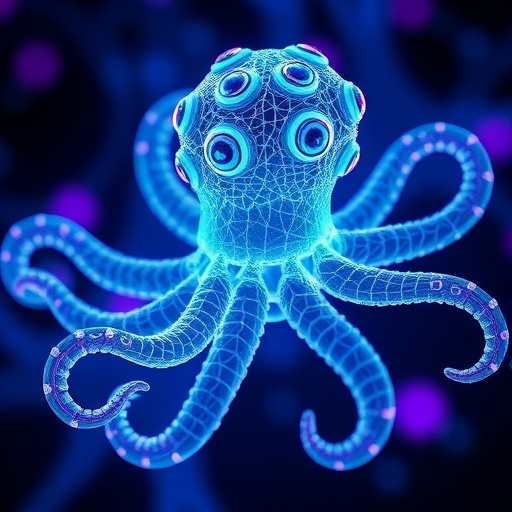In a groundbreaking advancement that could revolutionize wearable health technology and drug delivery systems, researchers have unveiled an innovative skin-adaptive nanofiber-based adhesive electronic device featuring biomimetic 3D suction cups inspired by octopuses. This cutting-edge development promises enhanced transdermal delivery by leveraging a novel approach that combines mechanical adhesion with ultraflexible electronics, ushering in a new era for non-invasive therapeutic treatments and continuous health monitoring.
The challenge of securely attaching electronic devices to the dynamic and irregular surface of human skin has long impeded the progress of wearable bioelectronics. Conventional adhesives often suffer from either inadequate skin conformability or cause discomfort and irritation during prolonged use. Addressing these limitations, the research team engineered nanofiber-based adhesive electronics that conform intimately to the skin’s microtopography, synchronizing with its natural movements without compromising attachment reliability or user comfort.
Central to their design is the fabrication of 3D microstructured suction cups that mimic the highly effective adhesion mechanisms of octopus suckers. Unlike simple sticky surfaces, these miniature suction cups create localized negative pressure zones that dramatically enhance their grip on the epidermis, even during sweating or vigorous physical activity. This bioinspired inspiration not only maximizes adhesion force but also facilitates reversible attachment, enabling the device to be easily repositioned or removed without damaging the skin barrier.
.adsslot_fB3Nq45tMe{ width:728px !important; height:90px !important; }
@media (max-width:1199px) { .adsslot_fB3Nq45tMe{ width:468px !important; height:60px !important; } }
@media (max-width:767px) { .adsslot_fB3Nq45tMe{ width:320px !important; height:50px !important; } }
ADVERTISEMENT
These suction cups are meticulously integrated with a nanofiber matrix, which itself is ultrathin and breathable, ensuring that the device remains unobtrusive and lightweight. The nanofiber scaffold serves as both a mechanical support and a medium for embedding flexible electronic circuits. These circuits maintain intimate electrical contact with the skin, allowing precise monitoring of physiological signals or targeted transdermal drug release.
Achieving the delicate balance between firm adhesion and gentle skin interaction required extensive material optimization. The team experimented with various polymer compositions and nanofiber fabrication techniques to replicate the soft yet resilient properties of octopus suction structures. Their resulting composite material demonstrated durability through repeated attachment cycles and resilience against moisture and oil secretions commonly present on human skin.
The device’s architecture also emphasizes breathability, a crucial factor for prolonged skin applications. The nanofiber network boasts high porosity, facilitating moisture vapor transmission and reducing risks associated with occlusion, such as skin maceration or irritation. This physiological compatibility ensures the device’s suitability for long-term wear, a vital characteristic for continuous health monitoring or chronic treatment applications.
One of the particularly innovative aspects lies in the seamless integration of sensing and therapeutic functionalities. The flexible electronics incorporated can monitor vital parameters like hydration levels, temperature, and electrophysiological signals, transmitting data wirelessly to external devices. Simultaneously, the platform can modulate drug delivery rates in response to real-time physiological feedback, embodying a closed-loop system that personalizes treatment for each individual.
Experimental validation demonstrated significant improvements in adhesion strength compared to traditional adhesives, with performance maintained across different skin types and anatomical locations. The reversible clinginess afforded by the suction cups also facilitated user comfort, with no observable damage or irritation even after multiple application-removal cycles. Such attributes affirm the potential of this technology in diverse scenarios, from fitness tracking to post-operative monitoring.
Furthermore, the research delineated the device’s capabilities in delivering pharmaceuticals transdermally. Model drugs embedded in the device exhibited enhanced permeation profiles owing to the sustained and intimate contact facilitated by the suction-based attachment. This suggests promising implications for managing chronic conditions requiring steady medication delivery without injections or oral administration, effectively reducing systemic side effects and enhancing patient adherence.
The potential scope of these skin-adaptive nanofiber-based electronic devices extends beyond healthcare. Their versatile adhesion mechanism and biointegration open pathways into virtual reality interfaces, human-machine interaction, and soft robotics. By providing a stable yet gentle adherence to skin, such platforms could support next-generation augmentative technologies that rely on precise, continuous skin contact.
Despite the remarkable progress, challenges remain before widespread adoption. Issues including long-term biocompatibility, integration with diverse pharmaceutical agents, and miniaturization of the electronics for multifunctional capabilities require further research. Nonetheless, the foundation laid by this bioinspired adhesive electronics system already sets a compelling precedent for future innovations in wearable and therapeutic devices.
This study exemplifies the fruitful convergence of materials science, bioengineering, and electronics, illustrating how nature’s designs can inspire technological breakthroughs that address real-world medical needs. By replicating the octopus’s unique adhesion strategy in a nanofiber electronic format, Song, Park, Kim, and colleagues have charted a vibrant path forward toward seamless human-device interfaces that adapt dynamically to the biological environment.
Looking ahead, the translation of these findings into clinical applications promises to facilitate non-invasive monitoring and treatment modalities that are patient-friendly and highly effective. The adaptability of the skin interface could further allow integration with emerging biomarker sensors and intelligent drug delivery systems, fundamentally transforming personalized medicine.
In a world increasingly defined by the convergence of biology and technology, innovations like skin-adaptive nanofiber-based adhesive electronics are paving the way toward a future where healthcare is continuous, unobtrusive, and precisely tailored to individual physiological needs. The octopus, an age-old marvel of nature, now inspires electronic devices that might soon enhance millions of lives through superior skin adhesion and controlled transdermal therapy.
Subject of Research: Skin-adaptive nanofiber-based adhesive electronics with biomimetic octopus-like suction cups for enhanced transdermal delivery and wearable bioelectronics.
Article Title: Skin-adaptive nanofiber-based adhesive electronics with octopus-like 3D suction cups for enhanced transdermal delivery
Article References:
Song, M., Park, HK., Kim, M. et al. Skin-adaptive nanofiber-based adhesive electronics with octopus-like 3D suction cups for enhanced transdermal delivery. npj Flex Electron 9, 54 (2025). https://doi.org/10.1038/s41528-025-00433-4
Image Credits: AI Generated
Tags: advanced wearable bioelectronicsbioinspired adhesion mechanismsbiomimetic suction cupscontinuous health monitoringdynamic skin attachmentnanofiber electronicsnon-invasive therapeutic treatmentsoctopus-inspired technologyskin-adaptive adhesive devicestransdermal drug delivery systemsultraflexible electronicswearable health technology





